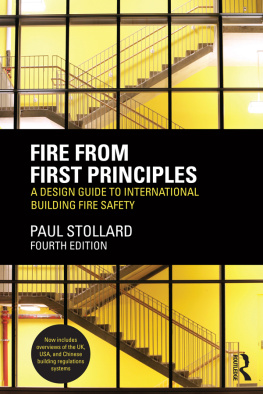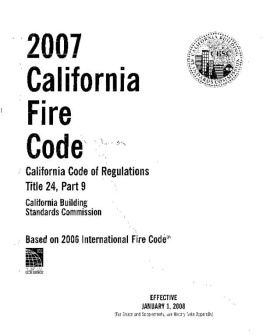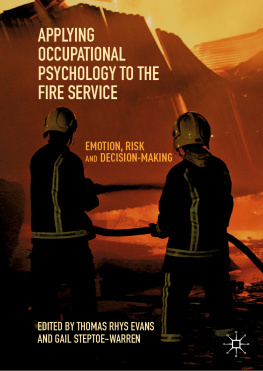Fire from First Principles
Fire safety is a fundamental requirement of any building, and is of concern to several professions which contribute to the construction process. Following on from the success of the previous three editions, Paul Stollard has returned to update and expand this classic accessible introduction to the theoretical basis of fre-safety engineering and risk assessment.
Avoiding complex calculations and specifications, Fire from First Principles is written with architects, building control officers and other construction professionals without fire engineering backgrounds in mind. By tackling an overview of the factors which contribute to fire risk, and how building design can limit these, the reader will gain a fuller understanding of the science behind fire regulations, safe design, and construction solutions.
All regulations content is fully updated, and has been expanded to cover the United States and China as well as the United Kingdom. The book is ideal for students of architecture and construction subjects, as well as practitioners from all built environment fields learning about fire safety for the first time.
Paul Stollard is an architect and chartered fire engineer who has worked in this field for over 30 years. He is a former Director of Abrahams Stollard Ltd, and has been Chief Executive of the Scottish Buildings Standards Agency and Regional Director for Scotland and Northern England with the Health and Safety Executive. He received the Peter Stone Award, the highest individual award given annually by the Association of Building Engineers for his work on fire engineering and building standards.
Fire from First Principles
A design guide to international building fire safety Fourth edition
Paul Stollard
with contributions from
Brian J. Meacham, W.K. Chow and X. Dong

First edition published 1991
Second edition published 1995
by E & FN Spon, an imprint of Chapman & Hall
Third edition published 1999
by E & FN Spon, an imprint of Routledge
This edition published 2014
by Routledge
2 Park Square, Milton Park, Abingdon, Oxon, OX14 4RN
and by Routledge
711 Third Avenue, New York, NY 10017
Routledge is an imprint of the Taylor & Francis Group, an informa business
2014 selection and editorial material, Paul Stollard; individual chapters, the contributors
The right of Paul Stollard to be identified as author of the editorial material, and of the individual authors as authors of their contributions, has been asserted in accordance with sections 77 and 78 of the Copyright, Designs and Patents Act 1988.
All rights reserved. No part of this book may be reprinted or reproduced or utilised in any form or by any electronic, mechanical, or other means, now known or hereafter invented, including photocopying and recording, or in any information storage or retrieval system, without permission in writing from the publishers.
Trademark notice: Product or corporate names may be trademarks or registered trademarks, and are used only for identification and explanation without intent to infringe.
British Library Cataloguing in Publication Data
A catalogue record for this book is available from the British Library
Library of Congress Cataloging-in-Publication Data
A catalog record has been requested for this book
ISBN 13: 9780415832618 (hbk)
ISBN 13: 9780-415832625 (pbk)
ISBN 13: 9781315852553 (ebk)
The three previous editions of this book were written jointly with John Abrahams, who sadly died in 2001. He was one of the first practical fire engineers in the British Isles, working hard to improve fire safety in many building types, most especially health buildings.
From our consultancy and teaching work in the 1980s, we had both come to realise that architects, and the statutory authorities, lacked a design-based guide to fire safety which would enable the underlying principles to be understood and incorporated at the earliest stages of an architectural project. Too many of the existing books simply expounded the legislation without real understanding, or over-complicated issues with too many detailed calculations. Therefore we wrote Fire from First Principles together. The first edition was published in 1991, and its preparation received financial support from The Interbuild Fund. It was such a success that subsequent editions appeared in 1995 and 1999.
This new and completely updated edition is dedicated to Johns memory.
Paul Stollard
Edinburgh
July 2013
Fire can be useful, but it can also be deadly. It has always fascinated and frightened; and as the proverb states; fire is a good servant and a bad master. Without fire, civilisation would be radically different, it might not even exist. However, the cost of fires which get out of control is high, and an average of seven to eight people die in fires in the United Kingdom every week.
There is a risk of fire in every building that is designed, and it is accepted that complete safety fire is an impossible goal. The fire risks inherent in different building types are normally only highlighted when a particularly serious and fatal fire attracts public attention, such as the fire in January 2013 at the Kiss nightclub in Brazil which led to the deaths of at least 241 people. Such major fires underline the importance of building design and remind architects of their responsibility to minimise the risks of fire in buildings.
However fire safety is not the only objective which an architect designing a new building has to fulfil. Aesthetic, functional, technological, economic, sustainability are also objectives which must also be satisfied, and there are many more. If the design is to be successful all these potentially conflicting objectives have to be integrated into a coherent whole during the design process. This is where the architects role is critical and the extent to which the integration is seamless is a measure of the expertise, and hopefully genius, of the architect. This book tries to help that process of integration by outlining the fundamental principles of fire safety so that architects, building surveyors and others in the design team can work from first principles to ensure an integrated design where safety is imperceptibly achieved without detriment to any of the other objectives. Where fire safety measures detract from the appearance, functionally or cost of a building then the architect has failed.
Legislation attempts to set minimum standards of safety with which architects must comply; but attempts to comply without understanding the logic behind the law will lead to either inadequate levels of safety or cumbersome compromises. The design team should never treat legislation as design guidance. Legislation is written for enforcement authorities to check the designs being produced are intrinsically and fundamentally safe, not for architects to use as the basis of the fire safety design.
Therefore this book does not start by describing the legislation, but instead works from first principles to establish a coherent understanding of building fire safety. The various tactics that the architect can use to ensure the safety of the occupants and the protection of the building are outlined as the basis for design. Working from first principles and considering fire safety throughout the design process, the architect will be able to achieve both safer buildings and ones where the fire precautions are less intrusive. Fire safety measures will be less obvious and more effective if designed in, rather than bolted on afterwards.
Although it is essential for architects to work from first principles, it is not necessary for them to become fire scientists. Therefore the principles are laid out as simply and clearly as possible; and to supplement these, a series of tables are included to offer approximate guidance on matters of fire escape and fire containment. These tables are intended particularly for student architects working at the sketch design stage, for whom it is far more important to gain a general idea of what is required, and why, than to understand the minutiae of codes and standards. The inclusion of these tables does not contradict the first principles approach of the book; rather they seek to provide rules-of-thumb which designers can use to check that they are heading in the right general direction.
Next page








